PWM, as known as pulse width modulation technology, has applications in many ways. In order to improve your comprehensive understanding of PWM dimming, this article will begin with the persistence of human vision and the common stroboscopic in life.
Persistence And Stroboscopic of Vision
Strobe is a perceptible flickering effect that usually occurs when a phone is shot towards an LED light source. Have you ever seen a stroboscopic image from a phone camera shooting an LED light source, but it’s normal when viewed directly with the naked eye? You can do a simple experiment by turning on your phone’s camera and pointing it at an LED light source, and also if your car has fluorescent lights, this strange phenomenon can be easily observed through a smart camera. In fact, the flickering frequency of the LED light source is imperceptible to the human eye.
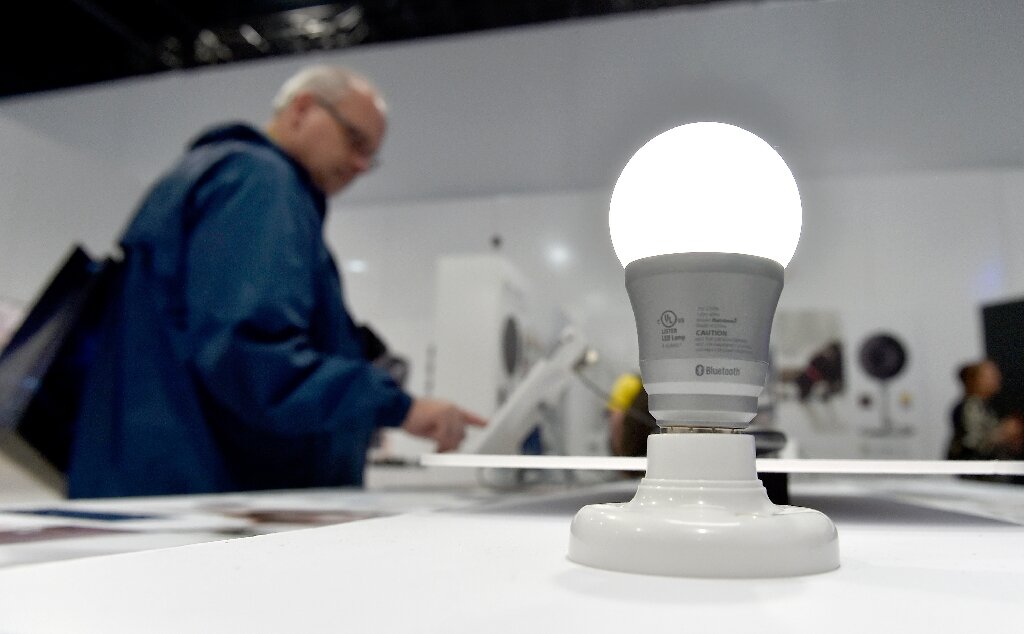
1. What is the stroboscopic effect?
If you look through previous physics books, you will see that people usually have a tendency, known as “persistence of vision”, where we are able to perceive things continuously, even when they are no longer in front of our eyes, we are able to see “persistent images” , rather than a discrete set of static images.
The LED light source flickers at a high frequency that is imperceptible to the naked eye, so we see that the light is on until we turn the power off completely. Also, a video is actually a series of images captured in rapid succession, which are captured in frames per second, and when we play images together, this constant vision tricks our brains into turning the screen away. The event above is regarded as a continuous fluid motion.
When the number of frames per second exceeds the frequency of the LED light source, the camera exhibits an obvious flickering effect, which is the stroboscopic effect.
LED light will flicker when it is rapidly switched on and off, depending on the nature of the current supplied to it. Usually LED lights flicker at such a high frequency that they cannot be directly detected by the human eye, or are invisible to the naked eye, so one can rest assured that any visible camera flicker is actually the light that is functioning properly, the only thing that should be of concern to humans is wink.

2. The origin of strobe
This story began before the appearance of display with the leading actor: strobe. This is really no exaggeration of the saying “the history of artificial lighting is the history of flickering”. It seemed that the flickering history of human lighting had been decided from the moment Tesla’s AC (Alternating Current) beat Edison’s DC (Direct Current). The reason is that all light sources operating on AC power flicker.
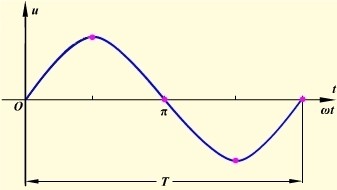
Since 1891, multiphase alternators have been used on a large scale. At last, 50Hz and 60Hz AC have occupied the market. The frequency of AC determines the flickering frequency of most household fluorescent lamps from antique tungsten filament lamps to 100Hz, that is, 100 times per second (sinusoidal alternating current of 50 Hz, which has 50 peaks and troughs per second, and passes through zero 100 times).
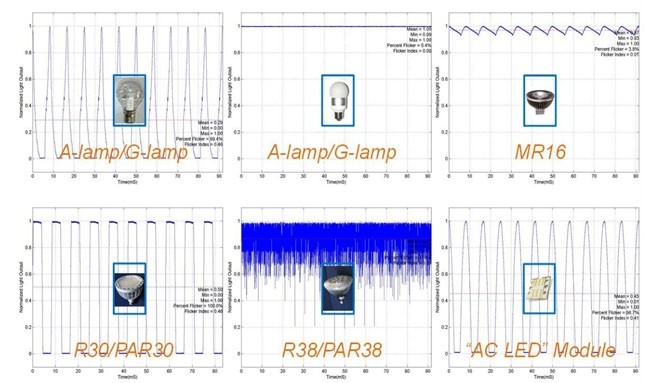
The LED light source, which has been placed high hopes on, has a very complex strobe because of the different driving circuits of manufacturers. If the dimming function is added, the strobe types are more and more complex. Of course, good products can be done without flickering or flickering very slightly. But after the price of LED products plummeted, many manufacturers used simple drive circuits, resulting in the deterioration of strobe.
Well, at this point you can see why slow-motion video taken indoors flickers. In addition to the flickering seen by humans unconsciously, even the scanning gun in a supermarket is affected by the flickering light.
3. Hazards of strobe
According to the definition of International Lighting Association, flicker can be divided into flicker effect and phantom effect, these two refer to the physical effect of observing objects and observer’s movement respectively. For simplicity, they will be called flicker and strobe in the following explanation.
The stroboscopic sensitivity of some people is very different, and there is even a “flash sensitive constitution”. The most sensitive frequency for human is 8.8Hz, and it keeps dropping. Most people can’t see flicker after 80Hz, but even so, some people still feel tired and sore of their eyes. IEEE Std states that flickering lighting will have potentially adverse effects:
- Photosensitive epilepsy or seizures induced by scintillation (0.1% of population).
- Migraines or severe headaches, often accompanied with nausea and visual disturbances.
- Increases repetitive behavior in people with autism.
- Weakness of vision includes exhaustion, fatigue and blurred vision.
4. The famous “strobe accident”
Looking back at the most famous stroboscopic accidents of recent times, it was like an urban legend. Who would have thought the main character would be Pokemon? On December 16, 1997, Japanese TV broadcast the 38th episode of Pokemon titled Computer Warrior Multilateral Beast. In order to render the battle in the computer world, a large number of 12Hz red and blue flashes were used to display the explosion scene, which directly led to 700 cases of epilepsy in Japan (650 cases were children). This low-frequency flicker, no matter what the monitor you looks at, may cause related symptoms.

This event is widely known as the “Pokemon Shock”. That makes the seemingly innocuous cartoon beloved by many around the world was taken off the air until April 16, the following year. It was resumed at the 39th episode while the 38th episode was permanently banned from television (but you can still find the video on internet). And the poor multilateral beast, whose whole family never appeared on TV again. Similarly, a trailer for London 2012 in 2007 and the Twilight Saga: Breaking Dawn in 2011 both caused epilepsy of some audience by color patches.
What is PWM?
1. PWM dimming
Come back to our central topic PWM dimming! PWM, or called Pulse Width Modulation, in the final analysis, is a kind of analog signal modulation into pulse wave technology. It is already a very widely used brightness control scheme for display/light sources, and there also contains DC dimming (CCR constant current dimming for LED, for convenience, we will call it DC dimming) which we will mention later.
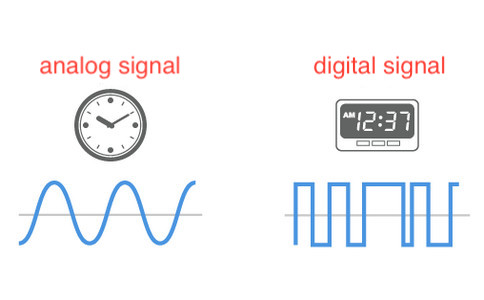
Before we get down to the central topic, let’s talk about the two main categories of signals:
- Analog signal, can have a range of values between 0 and 100% (close to infinitely variable speed)
- Digital signal, characterized by 0 and 1. These two are very geeky numbers, after all, the whole human IT system is built on the logic circuit “0 and 1” control.
Although the digital signal control cost is low, but it is awkward that no matter with high and low level mark, or light source power-off and power-on, it only correspond to “0 and 1” two states. For the dimming problem mentioned this time, the control of digital signal can only generate “on and off” two states, the brightness is either 0, or 100%. therefore, it is also doomed to do analog signal as stepless brightness adjustment.
Then why do our screens have stepless brightness? Because our human beings have found that the naked eye’s reaction speed is limited and imaginative. As long as the light source switch fast enough, the naked eye will not be able to detect it. PWM dimming come on stage like this: the effect of brightness control can be achieved by flickering to form a “carrier wave” and then controlling the time ratio of “on and off” (duty cycle) :

2. How to realize PWM dimming
PWM dimming, also known as digital dimming, turns on and off LEDs through PWM waves to change the on-time of forward current to achieve the effect of brightness adjustment. This method is based on the fact that the human eye is not sensitive enough to brightness flicker, so that the load LED is bright and dim at times. If the frequency of on and off exceeds 100Hz, the human eye sees the average brightness, not the LED flickering. PWM adjusts the brightness by adjusting the proportion of on and off time. Since the human eye is not sensitive to light flickering over 100Hz, the perceived brightness is a cumulative process. In a PWM cycle, the longer the proportion of the bright time in the entire cycle, the brighter the human eye feels.
3. Advantages of PWM Dimming
- No chromatographic shift will occur. Because LED always works at full current and 0.
- It can have extremely high dimming accuracy. Because the pulse waveform can be completely controlled to a high precision, it is easy to achieve a precision of one ten thousandth.
- It can be controlled by combining with digital control technology. Because any number can be easily transformed into a PWM signal.
- Even if the light is dimmed in a wide range, there will be no flickering phenomenon. Because the working conditions (boost ratio or step down ratio) of the constant current source will not be changed, problems such as overheating are less likely to occur.
4. Issues that should be paid attention to in PWM Dimming
Selection of pulse frequency. Because LED is in a fast switching state, if the operating frequency is low enough, the human eye will feel flickering. In order to make full use of the residual visual phenomenon of human eyes, its working frequency should be higher than 100Hz, preferably 200Hz.
Eliminate the whistling caused by dimming. Although the human eye cannot detect flickers above 100Hz, it is within the range of human hearing until 20kHz. So you may hear some voice. There are two ways to solve this problem. One is to increase the switching frequency above 20kHz, that is out of the range of human hearing. However, if the frequency is too high can cause some problems. Due to the influence of various parasitic parameters, the pulse waveform (front and rear edges) will be distorted, which will reduce the accuracy of dimming. Another way to go is to find out the sound device and deal with it.
5. The effect of PWM dimming
At more than N flickers per second, if the required brightness is low, we will let the ratio of off time to increase. For example, if you want to turn the light up to 10%, just make the lighting time ratio in 10%. Although it sounds crafty, the advantages of PWM dimming is quite a lot, simple structure, high precision and the control of “brightness change” will not lead to obvious color problem, besides saving electricity and having low heating. Our human eyes, and also those of most creatures on earth, evolved under continuous natural light.

Although, as mentioned above, most people cannot detect flicker beyond 80Hz, the peripheral vision can actually detect flicker at higher frequencies. The nervous system and cerebral cortex can detect stimulus at 160Hz, and the retina is more sensitive, which can respond to flicker at 200Hz. These have been shown to cause headaches, migraines and fatigue. Review the definition of stroboscopic from IEEE: stroboscopic, is the discrete phenomenon under the flashing light source, appeared when people observing the continuous movement of objects. When we read or move our eyes from the screen, the naked eyes can detect flickers of hundreds of Hertz because of the stroboscopic effect.
History of Displays
Every display device change in history has experienced some problems, for instance, those big, heavy CRT (cathode-ray tube) televisions and monitors. In addition to some pictures flickering caused by the scanning speed of the CRT, their pictures are transparent and gorgeous.
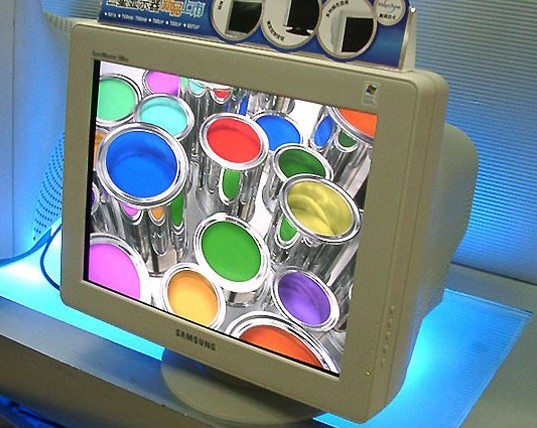
LCD monitors that followed were inferior to CRT except in size. Early desktop LCD had poor backlighting, resulting in poor gamut coverage and even worse viewing angles. More terribly, LCD was too expensive.
It took five or six years for the backlight of mainstream LCD and the large-scale use of IPS panels to catch up. In this period, desktop LCD screens have experienced scaling and resolution growth. The picture scales from 5:4, 4:3 to 16:10, and finally settled at 16:9. The resolution ranged from 1280*1024 and settled at 1920*1080.
Around 2010, the backlight of LCD displays underwent a switch from CCFL (cold cathode fluorescent tube) to LED. CCFL was banned by many countries and regions in the following 2 or 3 years due to environmental protection, power consumption and other factors. Then, for the first time, people feel the terror of “LED+ low-frequency PWM dimming”, a large number of users found that the new display looked more eyes harmful, and even stockpiling CCFL displays to again.
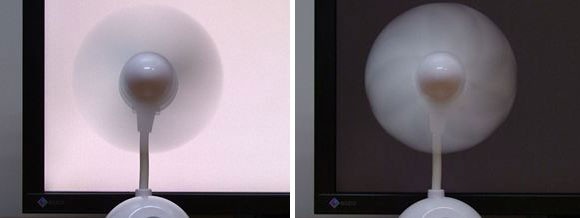
CCFL back-lit display, who has long been eliminated by history, whose PWM dimming frequency reached 175Hz, which slows down the stroboscope effect considerably though they have a significant afterglow effect (they still glow when PWM control goes off).
And the later LED back-lit display also uses low-frequency PWM dimming. Their frequency is usually between 180-420Hz. However, LED has fast respondence speed, so its afterglow effect is close to zero, and the flicker is so serious that it can produce a “stroboscopic effect” (the ability to freeze moving objects like high-speed photography).
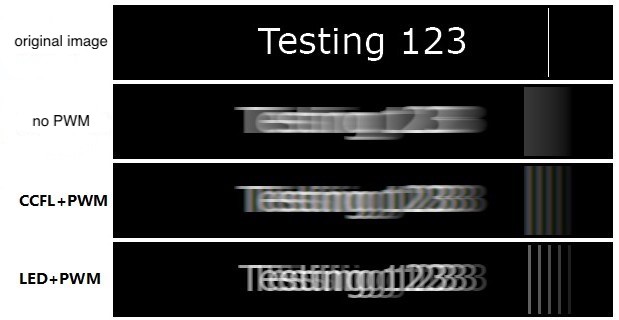
PWM dimming of monitors today
Those display manufacturers grasped this opportunity, and began to use DC dimming or DC+ high-frequency PWM dimming in a large scale, with “no flicker screen” as a means of promotion. Even nowadays, a large part of the display is still advertised with no flickering screen.
The notebook, sandwiched between desktop and phone, has long been accused of lacking a good panel and backlighting. Notebook market has a large number of low-frequency PWM dimming products, some are low brightness with PWM, some in the whole PWM. Many new products from a large number of notebook manufacturers, even high-end products, still use low-frequency PWM dimming.
Fortunately, the phone’s LCD screen hardly suffers from low-frequency PWM dimming. Even though the brightness of the LCD screen of some mobile phones fluctuates, it is completely different from the low-frequency flashing of the current OLED. However, just like the large-scale use of PWM dimming for desktop displays, the use of low-frequency PWM dimming by the OLED manufacturers like Samsung and LG reminds us of the terror of being dominated by PWM. If we say going from 16:9 to 18:9 full screen is still a progress, going from full screen to bangs screen is a step backwards, the usage of low-frequency PWM dimming in OLED screen is definitely a step back into the historical cycle pit.
DC Dimming VS PWM Dimming
Dimming, as the name suggests, is how the display adjusts the brightness.
DC Dimming
DC dimming refers to the dimming method in which the light source adjusts the brightness by adjusting the power level (Power = Current * Voltage, so changing the current and voltage can be achieved). The biggest benefit of DC dimming is that there is no flicker and no extra burden on the eyes.
Disadvantages of DC Dimming
So what are the disadvantages of DC dimming? This involves the types of mainstream display screens: LCD and OLED.
In layman’s terms, LCD is a backlight + a bunch of small grids (each grid is a pixel, and the pixels do not emit light), and OLED is a bunch of small grids that emit light (the pixels themselves emit light). The former can be seen as a single lamp, while the latter is millions of lamps (1920×1080 resolution, which is 2073600 lamps). Adjusting the brightness of one light is obviously different from adjusting the brightness of millions of lights. When the light is dimmed, due to the reduction of the voltage and current of each lamp, the relative error begins to increase. Millions of OLED lamps are prone to inconsistent color and brightness, which is the legendary “rag screen” phenomenon.
Disadvantages of PWM Dimming
In order to solve the rag screen problem of OLED at low brightness, PWM dimming appeared. It uses the visual residue of the human eye to control the brightness of the screen through the continuous alternation of light and dark of “bright screen – off screen – bright screen – off screen”. At 100% brightness, the screen is always on; at 50% brightness, as long as the screen is off half of the time, our eyes will mistakenly think that the screen brightness has dropped. PWM dimming will keep on and off alternately, you may not see the flickering, but the eyes will bear additional burden, which will increase eye fatigue.
Final Thoughts
Due to individual differences, different people have different sensitivity to the dimming frequency. If you use very low frequency PWM dimming without any discomfort, then congratulations, your eyes can perfectly adapt to most screens.
However, for our eye health, a display with DC dimming is the most ideal choice. If you care about the display effect of low brightness or choose a display screen that has to use PWM dimming, you may choose a product with the highest dimming frequency as possible. According to the national standard of performance requirements for reading and writing work desk lamps, the standard for this frequency is 1250Hz, so PWM dimming higher than this frequency will have a negligible burden on the eyes.
Read more: Battery Powered TV, LED Ring Light and On Camera Video Light.